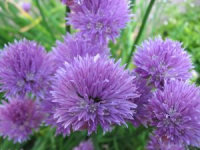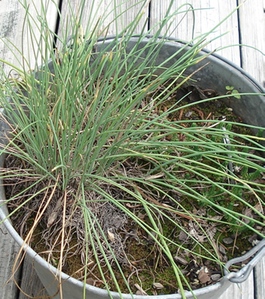Chive Characteristics
(Allium schoenoprasum)

Name Origin:
It’s English name derives from the French word cive, which was derived from cepa, the Latin word for onion.
Natural Order:
Liliaceæ
Growing Cycle:
perenial
Height:
chives grow in clumps six to ten inches tall, bloom stalks can grow up to 24 inches
Appearance:
An onion-like plant with hollow, grass-like leaves.
Flowers:
Spiky, purple flower heads.
Fun Facts.
Chives are not actually classified as an herb. Additionally, even though most people say ‘chives’, chive is actually both the singular and plural version for this tasty plant.
Growing Chives
(Seeds, propagation and harvest)
Growing Chive From Seeds
 Chive seeds are quite small. When growing chive from seed, they prefer a light covering and keeping them in the dark will actually aid in germination. Plant seedlings six to eight inches apart. Plant seeds directly into the garden 1/4 of an inch deep after soil has fully thawed and warmed.
Chive seeds are quite small. When growing chive from seed, they prefer a light covering and keeping them in the dark will actually aid in germination. Plant seedlings six to eight inches apart. Plant seeds directly into the garden 1/4 of an inch deep after soil has fully thawed and warmed.
If you are planning on growing chives for seed, it’s recommended to maintain 2 separate beds – one for seed production and one for harvest. Seeds are formed within the flowers that bloom in June and July. Like many plants, allowing a chive plant to flower will shorten your harvest.
While the weather this summer didn’t leave our chive plants very happy, as you can see, they grow nicely in a pot on our deck. This photo was taken near the end of the season but as you can see, we still have plenty of fresh chive to use in the kitchen.
Before planting chive in your garden, check out our Chive Companion Planting Guide to learn what other herbs and vegetables would benefit from being planted with chives.
Propagating Chives
Chive plants are propagated by dividing the clumps in the spring or fall. The clumps will consist of a number of small bulbs – leave at least 6 bulbs in each division. However, for best results, do not grow chives in the same place for more than 3 years.
Chive Harvest
Cut leaves with shears fairly close to the ground. This will stimulate growth and improve the tenderness of the leaves with each successive harvest.
Chive Uses
(leaves)
Dried, frozen or fresh, chive leaves are often used for a mild onion flavoring in salads, stews and other dishes. They are a favorite addition to baked potatoes and omelets.
One historical source mentioned feeding newly-hatched turkeys chopped chives with their food.